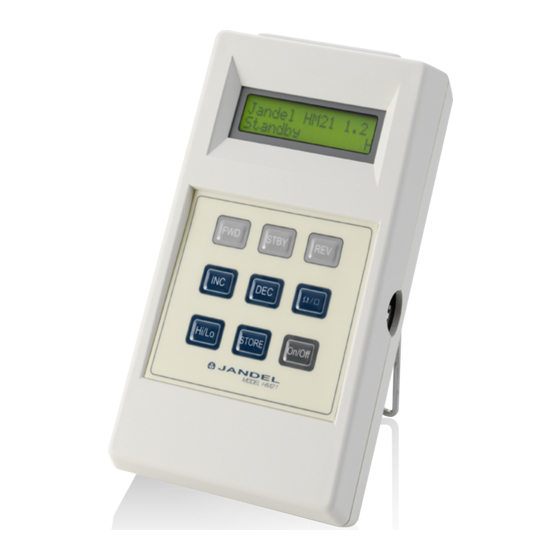
Advertisement
Quick Links
HM21 Test Unit
PORTABLE COMBINED CONSTANT CURRENT SOURCE AND VOLTMETER
Jandel Engineering offers the HM21 Test Unit for use in making four point
probe measurements. The HM21 has six constant current settings between
100nA and 10mA, and can be used to measure voltages from 0.01mV to
1250mV.
The quoted measurement range of the HM21 is from 1 ohm/square to 10
Megohms/square (sheet resistance), from 0.01 ohm.cm to 10 Kohm.cm (bulk
resistivity).*
Measurements can be displayed as mV values or directly in sheet resistance
values. Up to 50 readings can be stored in onboard non-volatile memory for
downloading to a PC using the free software included. The software can also
be used to operate the unit directly from a PC, and to output results as sheet
resistance, bulk resistivity, or 'bulk resistivity for wafer' values.
The HM21 enables current to be passed in a forward and reverse direction to
verify good contacts and measurements.
Overall accuracy is 0.5%, highest accuracy is in the mid-range of measure-
ments.
Connection to a computer can be made via USB connection, and the unit
can be operated standalone, via a graphical interface in the free software
provided, or by computer keyboard commands.
The HM21 can be powered using the supplied adapter or using four size AA
rechargeable batteries (supplied).
*
measurements outside this range are possible depending on sample type and possible reduced accuracy
Jandel Engineering
Limited
Jandel Engineering
Limited
Grand Union House
Leighton Road
Leighton Buzzard
Beds.
LU7 1LA
Phone: +44 (0)1525 378554
Fax: +44 (0)1525 381945
E-mail: info@jandel.co.uk
Web: www.jandel.com
Advertisement

Summary of Contents for Jandel HM21
- Page 1 PC, and to output results as sheet resistance, bulk resistivity, or ‘bulk resistivity for wafer’ values. The HM21 enables current to be passed in a forward and reverse direction to verify good contacts and measurements.
- Page 2 The Jandel HM21 The Jandel HM21 is a portable meter designed for use with a four point probe to make resistivity measurements. For successful measurements the HM21 supplies a constant current and displays either the resultant voltage or the sheet resistance in ohms/square depending which function has been chosen.
- Page 3 When pressed the ‘STBY button puts the unit in ‘Standby’ mode When pressed the ‘REV’ button allows current flow in the ‘reverse’ direction When pressed the ‘INC’ button increases the current by one level (10mA max.) When pressed the ‘DEC’ button decreases the current by one level (100nA min.) □...
- Page 4 24-48 hours. The batteries charge slowly to give maximum lifetime and charge. Plug the AC adapter into the HM21 and connect the lead to the mains. A green light on the adapter indicates that the power is on.
- Page 5 ‘FWD’ key. This will cause an error and the message “Contact Limit” will be displayed. By removing the resistor we have made it so that the HM21 can’t drive the current – you can therefore equate this to a four point probe being on a sample but the HM21 having a problem driving the current through.
- Page 6 Press the ‘On/Off’ button to switch the HM21 off. Note that it can take up to 5 seconds for the unit to switch off – the button only needs pressing once!
- Page 7 Command is via simple single character commands. Data Output data is in the form of comma separated variables (CSV). Sending an "o" to the HM21 causes it to Send or Output the set Current and the Voltage Reading displayed at that time.
- Page 8 Once the driver is correctly installed, connecting the HM21 will add a com port to your PC, and you can configure your PC to control or receive data over the port. The com port number will vary depending on your PC configuration. For laptops the com port is usually 2 and for desktops without a modem it is often 3, but these are only a general guide and you will need to determine this yourself.

Need help?
Do you have a question about the HM21 and is the answer not in the manual?
Questions and answers